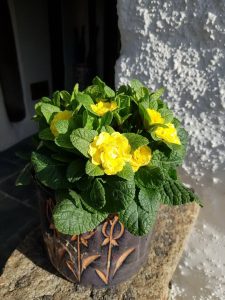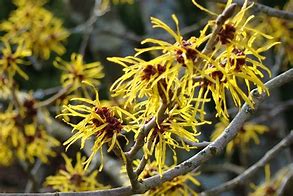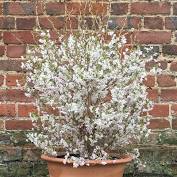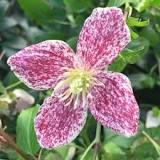We were very grateful to Peter Burks, garden centre manager, Fermoy’s garden centre, for agreeing to talk to us, at quite short notice, when our booked speaker pulled out. It turned out to be a very enjoyable evening.
Peter Burks has a degree in horticulture and worked in garden centres around the south-west before accepting his present position with Fermoy’s. He brought with him a large number of plants, all with winter interest of some kind, either flowers, leaf colour or bark colour.
 He started his talk with winter-flowering pansies. These familiar plants are hardy, flower reliably and are long-lasting. For best results, buy them in flower in late autumn or early winter and place in a sunny position.
He started his talk with winter-flowering pansies. These familiar plants are hardy, flower reliably and are long-lasting. For best results, buy them in flower in late autumn or early winter and place in a sunny position.
Next chronologically are hardy cyclamen (not to be confused with winter-flowering cyclamen sold as house plants). Cyclamen do well under trees (provided the site is not too dry) and bring winter cheer to gardens and containers.
Peter brought some lovely primulas (I bought a Primula Belarina from him, which you will see if you pass my front door). There is a huge variety of these plants, with single, semi-double and double flowers. Remember to deadhead these.
Peter asked what the difference between a primula and a polyanthus is and one of our expert members correctly pointed out that polyanthus has a single strong stem bearing a cluster of flowers, while primulas have many short stems, each with a single flower.
expert members correctly pointed out that polyanthus has a single strong stem bearing a cluster of flowers, while primulas have many short stems, each with a single flower.
Snowdrops should be bought in a pot in early September. Plant them immediately and don’t let them dry out.
All the above-mentioned plants will reflower year after year, except that pansies are usually replaced.
Peter then turned to bulbs. Hyacinths and daffodils are hardy and reliable and prefer a reasonably sunny position. Dividing them when they form clumps will reward you with an improved display. Please remember to enter your daffodils in our Spring Show!
Campanula are flowering earlier nowadays, probably due to climate change. Hebe pascal has lovely purple foliage in winter and is suitable for a pot. Just clip with shears after flowering to keep it the size you want.
Erysimum (wallflower) will flower all year in a sunny position. They are short-lived, so take cuttings.
 Hamamelis or witch hazel prefers a slightly acidic soil. They have fragrant blooms and autumn colour. The RHS suggests growing them behind Sarcococca (Chrismas box) which also has a lovely scent. Look for small plantlets under your Christmas box. (I’ve just been to look under mine, and yes, there were some little plants – will pot them up and see what happens.)
Hamamelis or witch hazel prefers a slightly acidic soil. They have fragrant blooms and autumn colour. The RHS suggests growing them behind Sarcococca (Chrismas box) which also has a lovely scent. Look for small plantlets under your Christmas box. (I’ve just been to look under mine, and yes, there were some little plants – will pot them up and see what happens.)
Cut cornus (dogwood) down hard in March for lovely coloured stems (and perhaps use your cuttings for propagation). Camelias such as Sasanqua Yule Tide have a long flowering season, but need acidic soil.
Grevillea has exotic looking flowers from October to March and likes a sunny position.
The hardy viburnum gives a good show of flowers, though I notice it has been greatly over-used by whoever planted up the gardens of the new Bovis development at Bradley Bends.
Escallonia glowing embers and Choisya sundance both have lovely yellow leaves and need sun to maintain the leaf colour. Lonicera fragrantissima has fragrant winter flowers and also benefits from full sun. Abelia is another shrub which likes full sun, and while summer flowering, retains the bracts over the winter.
There are many varieties of hellibores, but plant them where they will not dry out.

Prunus kojo-no-mai is a small, very hardy cherry blossom which is ideal for a pot. Grow in half or full sun.
 Thuja rhinegold is a pyramid-shaped conifer with an attractive rusty-red colour. It is suitable for a container, rockery or small border.
Thuja rhinegold is a pyramid-shaped conifer with an attractive rusty-red colour. It is suitable for a container, rockery or small border.
Vinca minor needs a sunny spot and will flower all year. I am about to move mine from its north facing position – no wonder it has hardly any flowers!
Winter-flowering jasmine doesn’t mind where you plant it, but it needs support, or you could plant it where it could tumble down without support.  Cut it back hard (by 2/3) after flowering. Clematis cirrhosa is winter flowering and needs full sun. “Freckles” produces a lovely red streaked flower. You could hide it among your summer flowering clematis. It needs moisture and feeding, but no need to prune.
Cut it back hard (by 2/3) after flowering. Clematis cirrhosa is winter flowering and needs full sun. “Freckles” produces a lovely red streaked flower. You could hide it among your summer flowering clematis. It needs moisture and feeding, but no need to prune.
Peter recommended the use of mycorrhizal fungus to help roots develop. Remember the fungus needs to be in contact with the roots – there is no point trying to water it in.
Lastly, he recommended the use of a 1:1 mixture of Jack’s Magic compost and John Innes No 3.
